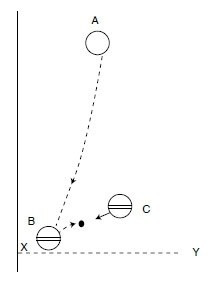When off side 1. A player is off side except when he is in his own in-goal if the ball touches, is touched, held or kicked, by one of his own team behind him.
Out of Play 2. An off side player shall not take any part in the game or attempt in any way to influence the course of the game. He shall not encroach within ten metres of an opponent who is waiting for the ball and shall immediately retire ten metres from any opponent who first secures possession of the ball.
Placed onside 3. An off side player is placed onside if:
(a) an opponent moves ten metres or more with the ball.
(b) an opponent touches the ball without retaining it.
(c) one of his own team in possession of the ball runs in front of him.
(d) one of his own team kicks or knocks the ball forward and takes up a position in front of him in the field of play.
(e) he retires behind the point where the ball was last touched by one of his own team.
ALSO NOTE
Catcher claiming off side 1. A player who catches the ball near an off side opponent must not go out of his way to make interference in play by the offside player unavoidable. He should proceed with normal play and rely on the Referee to penalise the off side player if the latter interferes with play. If the catcher deliberately and unnecessarily runs into the off side player then play should proceed.
Accidental off side Where the Referee is satisfied that interference with play by an off side player is accidental he should order a scrum.
Interfering with Catcher 2. Any off side player who remains within ten metres of an opponent who is set to catch a kick up field by an opposing player shall be deemed to be interfering with or attempting to interfere with the catcher and shall be penalised unless the non-offending team gains an immediate advantage.
“Out of Play” as opposed to “off side” 3. Players who are out of play at a play-the-ball (Section 11), a scrum (Section 12), a kick off or drop-out (Section 8) a penalty kick (Section 13) or a free kick (Section 13) are not put “on side” in the manner described in para 3 above. (See appropriate Sections).
“Down town” Any player who is in front of the kicker in general play is not permitted to advance beyond the point of the previous play the- ball until the ball has gone past the off side players. This rule delays the movement of the off side players downfield in an attempt to encircle the ball receiver as he collects the ball.

Example of offside player retrieving ball 3. (e)
Player A kicks the ball and opponent B attempts to catch it. He drops the ball which rolls behind him. His colleague C who was originally in front of him drops back to retrieve the ball. When he gets to it he is behind the point at which it was played by B, indicated by the line XY, and is not off side.

Player A kicks the ball and opponent B fails to catch it, the ball bouncing forward off his hands. Player C is off side if he plays the ball unless B advances in front of the ball before C reaches it, in which case a scrum would be ordered for a knock-on.